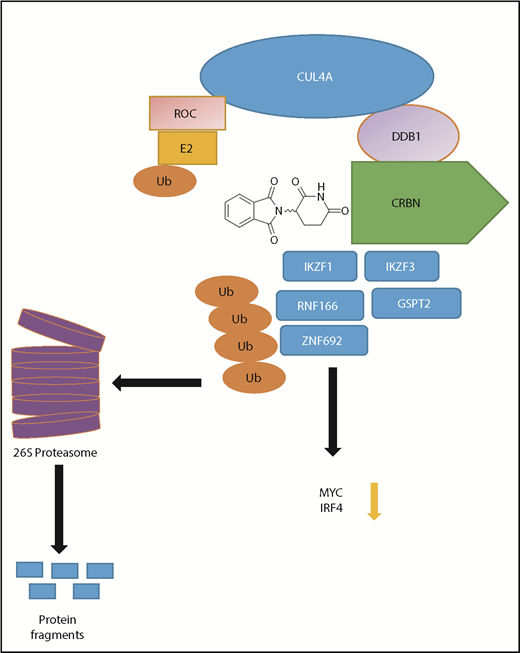In this issue of Blood, Sperling et al describe the biological determinants underlying the activity of thalidomide analogs in a given cell and potential mechanisms of resistance. By developing a quantitative mass spectrometry (MS)–based assay, they measured the levels of cereblon (CRBN) and thalidomide analog protein substrates to characterize the activity of thalidomide analogs and identify novel modes of drug resistance.1
Cullin-RING E3 ubiquitin (Ub) ligase complex and thalidomide analog protein substrates. Schematic representation of the CRL4CRBN complex and its competing substrates. DDB1, damage specific DNA binding protein 1; E2, ubiquitin-conjugating enzyme E2; ROC, regulator of cullins.
Cullin-RING E3 ubiquitin (Ub) ligase complex and thalidomide analog protein substrates. Schematic representation of the CRL4CRBN complex and its competing substrates. DDB1, damage specific DNA binding protein 1; E2, ubiquitin-conjugating enzyme E2; ROC, regulator of cullins.
Thalidomide and its analogs exert significant activity in the treatment of several hematologic malignancies, especially multiple myeloma (MM) and myelodysplastic syndrome (MDS). They bind to CRBN,2 a substrate receptor in the cullin-RING E3 ubiquitin ligase complex (CRL4CRBN), and in MM they are known to induce proteasomal degradation of transcriptional factors Ikaros and Aiolos3,4 with an ensuing transcriptional repression of MYC and IRF4, two important proteins for MM proliferation and survival (see figure). In del(5q) MDS, the target critical for drug activity is the casein kinase 1α (CK1α) encoded by CSNK1A1.5 Several other thalidomide analog–induced substrates have been described,6 but how these substrates interact with one another and whether they influence drug activity is still unknown. Our understanding of the determinants of activity and resistance of thalidomide analogs in a given cell is also limited.
MS is one of the most commonly used technologies for quantifying proteins in complex samples, and it has excellent assay specificity as a result of direct detection of the mass-to-charge ratio of each target molecule. However, MS-based proteomics has a bias toward measuring high-abundance analytes, so it is challenging to detect low-abundance analytes at ng/mL or pg/mL concentrations in complex samples. Therefore, immunoaffinity enrichment and targeted MS approaches such as multiple-reaction monitoring (MRM) have been developed to measure low-abundance proteins with high specificity.7 Sperling et al used immunoaffinity enrichment and MRM-targeted MS with a heavy isotope–labeled peptide to detect thalidomide analog–induced substrate degradation, and they demonstrated that the assay is sensitive, quantitative, and precise. Not surprisingly, they observed that substrate sensitivity is dependent upon the ability of individual drugs to induce strong binding of a given substrate to the CRBN adaptor protein. Therefore, the degree of drug-induced substrate binding drives both the rate and degree of substrate degradation. The authors demonstrated that once this binding occurs, the rate of substrate degradation depends on the level of CRBN, which confirms that MM cell sensitivity to thalidomide analogs correlates with CRBN expression levels. In addition, the authors demonstrated that multiple substrates compete for access to a limiting pool of CRBN, which leads to an ordered degradation of substrates. In their article, Sperling et al also delineate how the variable thalidomide analogs differ in their substrate binding and explain their differential cytotoxicity and potency. Therefore, cellular sensitivity to thalidomide analogs is determined by a complex interplay that involves not only the expression levels of the CUL4A E3 ubiquitin ligase and its adaptor CRBN but also the stability of the ternary complex (E3 ligase-thalidomide analog-substrate) and, importantly, the cellular expression and abundance of competing substrates.
Overall, the results presented by Sperling et al are pivotal to expanding our understanding of thalidomide analogs’ mechanisms of action and MM cells’ acquired resistance to the drugs. In particular, these findings highlight a potentially novel mechanism of resistance to this class of drugs mediated by competition between substrates for access to a limiting pool of the E3 ubiquitin ligase. However, the clinical relevance of this competing substrate model remains to be confirmed in large transcriptomic data sets available from clinical trials that evaluate the clinical efficacy of these drugs. In particular, the data provided by the authors suggest that overexpression of competing substrates has a modest protective effect in cells exposed to lenalidomide. Current knowledge clearly supports that CRBN-truncating mutations that result in the loss of CRBN8 or posttranscriptional modification to the CRBN thalidomide-binding domain (exons 10 and 11)9 are implicated in MM cells’ resistance to thalidomide analogs.
Through rigorous scientific studies, we have finally come to understand the mechanisms that led to the tragic teratogenic effects of thalidomide in the 1960s. Current studies are helping us begin to unravel the mechanisms that mediate the activity of and possibly resistance to this class of drugs in variable hematologic malignancies. The success of thalidomide analogs as anticancer agents has reinvigorated the development of degronimids and proteolysis-targeting chimera (PROTAC) technology as active areas of drug development.10 Approaches such as the immuno-MRM assay described by Sperling et al will be essential for determining the activity of the developed E3 ligase-engaging degraders and the accurate measurement of target substrates. From tragic beginnings to a triumphant ending, thalidomide analogs are the Pandora’s box that never stops amazing us!
Conflict-of-interest disclosure: The author declares no competing financial interests.


